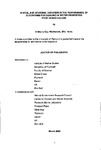SPATIAL AND SEASONAL VARIATION IN THE PERFORMANCE OF ALGORITHMS FOR DERIVING IN-WATER PROPERTIES FROM OCEAN COLOUR
| dc.contributor.author | Westbrook, Anthony Guy | |
| dc.contributor.other | School of Biological and Marine Sciences | en_US |
| dc.date.accessioned | 2013-09-13T10:27:55Z | |
| dc.date.available | 2013-09-13T10:27:55Z | |
| dc.date.issued | 2000 | |
| dc.identifier | NOT AVAILABLE | en_US |
| dc.identifier.uri | http://hdl.handle.net/10026.1/1689 | |
| dc.description.abstract |
The on-going calibration and validation of visible satellite imagery remains a core activity of the scientific community in pursuit of high quality data characterising the oceanic chlorophyll field, providing input to models assessing primary productivity and the potential role of the oceans in climatic regulation. This work serves to examine the operational characteristics of semi-analytical algorithms that are designed to derive key optical properties from space born observations of ocean colour. The collection of water samples contemporaneously with precision profiled radiometry conforming to similar spectral bands to those of the NASA Sea Viewing Wide Field of view Sensor (SeaWiFS) was planned and executed, with appropriate field sampling techniques developed in accordance with the SeaWiFS Ocean Optics protocols (Mueller and Austin, 1995). Data were collected during extensive fieldwork sampling at a near coastal survey site and during two deep Atlantic research programmes. Historical and recently developed algorithms designed to retrieve the diffuse attenuation coefficient at 490nm and chlorophyll-a pigment concentrations from upwelling radiances were applied to the optical data, to compare the mathematically retrieved in-water properties with the values measured in-situ. The radiometric data were then used to generate general and local algorithm modifications to assess possible differences in the mathematically retrieved values. Statistical analyses of the errors in mathematical retrieval of in-water properties identified stmctured variability resulting from the empirical approach to algorithm generation, supporting the point of view that locally constrained algorithms provide a method of achieving significantly improved results. The problems associated with the derivation of semi-analytical algorithms are then discussed and errors analysed. The new algorithms generated here are found to compare well with their source data and with work by other investigators. Systematic variability was found within the data sets and the affect this has on the determinations is discussed. It is suggested that data users be afforded details of the equations employed in the production of readily available remote sensing products, placing them in a position where they are better able to assess the data in the context of their work. | en_US |
| dc.description.sponsorship | Natural Environment Research Council Centre for Coastal and Marine Sciences Plymouth Marine Laboratory Prospect Place West Hoe Plymouth Devon UK PL4 3DH | en_US |
| dc.language.iso | en | en_US |
| dc.publisher | University of Plymouth | en_US |
| dc.title | SPATIAL AND SEASONAL VARIATION IN THE PERFORMANCE OF ALGORITHMS FOR DERIVING IN-WATER PROPERTIES FROM OCEAN COLOUR | en_US |
| dc.type | Thesis | |
| plymouth.version | Full version | en_US |
| dc.identifier.doi | http://dx.doi.org/10.24382/4234 | |
| dc.identifier.doi | http://dx.doi.org/10.24382/4234 |
Files in this item
This item appears in the following Collection(s)
-
01 Research Theses Main Collection
Research Theses Main


